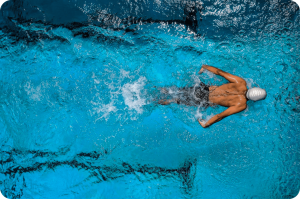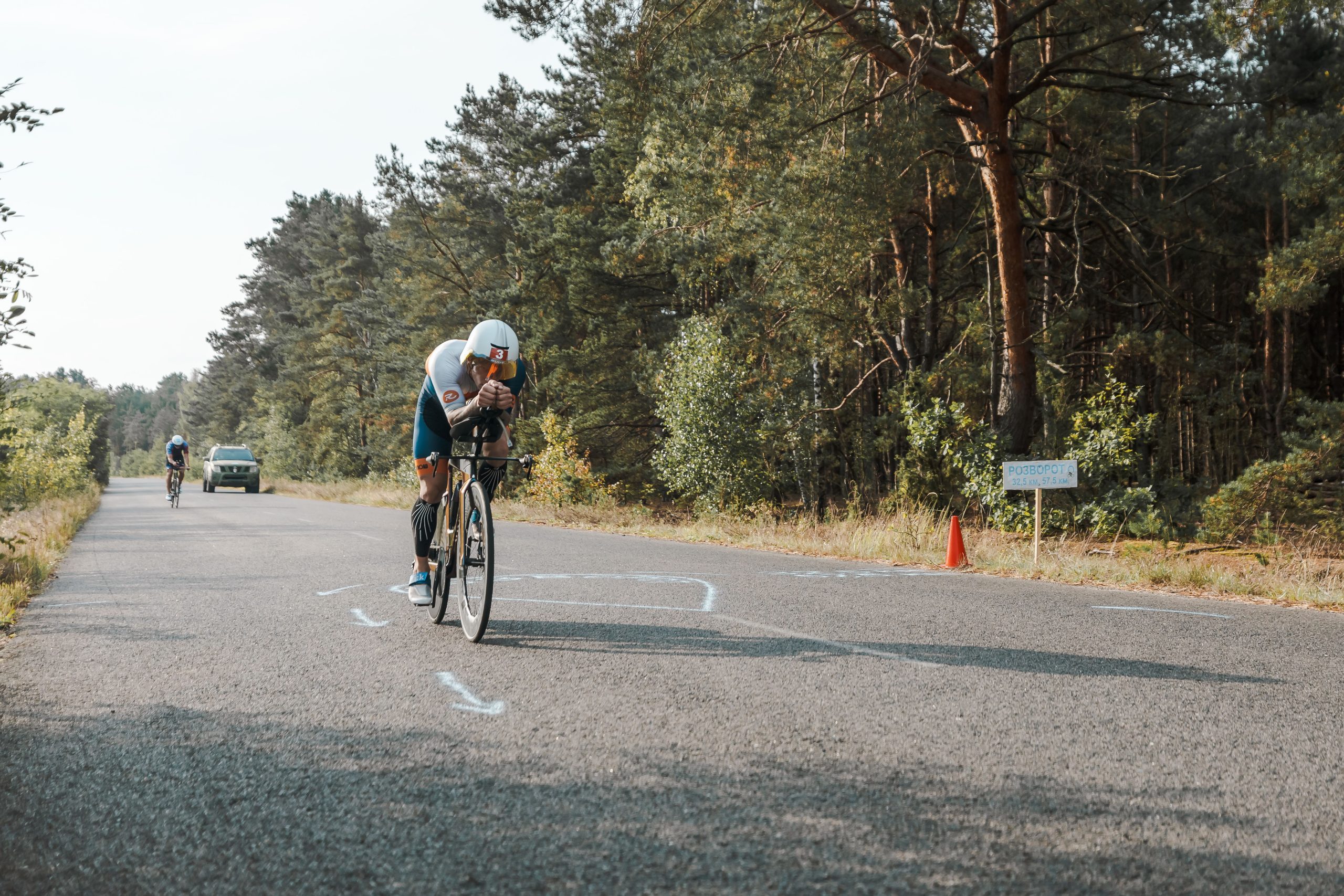When you check your SWOLF swimming score the first time, you might be confused and have no idea what to make of it. The number may seemed high, your strokes felt all over the place, and no matter how hard you tried, you couldn’t get any faster. Does it sound familiar?
If you’ve ever felt like you’re working harder than necessary in the pool, SWOLF might be the key to unlocking better efficiency. In this article, we’ll break down what SWOLF is, why it matters, and how you can use it to swim smarter — not harder, and achieve better SWOLF scores.
And if you are training for your first ever Ironman and struggle to incorporate workout sessions into your busy lifestyle, this handy guide on how to train for an Ironman while working full time might be what you need at this point.
What is SWOLF Swimming?
The term “SWOLF” blends “swimming” and “golf,” reflecting its goal to achieve a lower score, similar to golf. Swimmers and triathletes widely use it to monitor and improve their technique and efficiency.
The SWOLF score is simply a metric that allows you to measure swim efficiency in the water. To calculate your SWOLF, you need to lap split (this is how long it takes you to go from one end of the pool to the other end of the pool) and add that to your stroke count (how many strokes you take). If it’s freestyle or backstroke, every time your arm is doing a pull, that counts as a stroke. If you are doing breaststroke and butterfly, both arms together count as one stroke.
Take that summation and normalize it to a 25-meter pool. If you already swim in a 25-meter pool, you do not have to do anything. Just take the number of strokes you take and add it to how long it takes you to get across the swimming pool.
The SWOLF score formula looks like this:
SWOLF=Time (seconds)+Stroke Count
For instance, if you swim 25 meters in 30 seconds with 20 strokes, your SWOLF score is 30+20=50.
Open-water swimmers can calculate SWOLF using GPS-enabled devices over intervals of 25 meters.
What do SWOLF Scores Mean?
A SWOLF score is a measure of swimming efficiency that combines the number of strokes taken and the time it takes to swim a lap. The score is calculated by adding the number of strokes taken to the time in seconds it takes to complete the lap. For example, if a swimmer takes 30 strokes to swim a lap and completes it in 40 seconds, their SWOLF score would be 70.
Understanding SWOLF scores is essential for swimmers who want to improve their efficiency in the water. A lower SWOLF score indicates increased speed and efficiency, while a higher score indicates a need for improvement. By tracking SWOLF scores, swimmers can identify areas for improvement and work on reducing their stroke count while maintaining speed.
What is a Good Swolf Score?
A good SWOLF score varies based on the swimmer’s skill level, physical attributes, and goals.
The average SWOLF score depends on multiple factors including your skill level, stroke type, and pool length.
For a 25m pool, scores between 35–45 are considered very good. For a 50m pool, scores in the low 70s are excellent.
A lower SWOLF score typically indicates fewer strokes and better swimming efficiency, which is crucial for swimming fast.
In general:
- Beginner swimmers: 45–55
- Intermediate swimmers: 35–45
- Advanced swimmers: 30–35
- Elite swimmers: 25–30
As a triathlete, you might be focused more on open-water efficiency rather than SWOLF (which is pool-specific). So, take this into account, as your scores can fluctuate based on factors like wetsuits, drafting, and race conditions.
Jan Frodeno, an Olympic & Ironman World Champion, has estimated SWOLF of ~30–35 in a 25m pool. His swim speed is ~1:10 per 100m in Ironman races.
Benefits of Tracking SWOLF
The great thing about SWOLF and using and using it as a metric to measure your progress and improvement in efficiency over time is that it is universal for each stroke regardless of the swimming pool you are using. So, whether you swim in a 25-yard pool length or a 50-meter pool, you can measure your SWOLF score regardless of the measure of the pool that you swim in.
Another important point about the SWOLF score is that it is unique to the different strokes. It will be different for the freestyle swim, butterfly swim, backstroke, and breaststroke as well.
Also, SWOLF scores are unique to you as a swimmer. So, it really doesn’t make sense to compare your score to someone else’s. No need to wonder what is a good SWOLF score. Your SWOLF score is good if it is lower than the last time you measured it, and that is how you know you are improving your swimming efficiency.
The lower your SWOLF score is, the better it is for your efficiency.
While the SWOLF score is a really good metric to track over time, there is a number of other things that play into the effect. Some of the best swimmers in the world do not actually have the lowest SWOLF score, unlike golf, where the lowest score wins. And swimming efficiency is about the time, at the end of the day.
There are multiple benefits to tracking your SWOLF score.
Use your SWOLF score to monitor improvements in both speed and technique over time.
Scores are unique to each swimmer due to differences in physiology (e.g., arm length) and swimming style. Comparisons are most meaningful when tracking your own progress rather than comparing with others.
Experiment with stroke rates, body rotation, and pull strength to find an optimal balance between speed and effort.
Tracking SWOLF Scores
Various devices and apps can be used to track SWOLF scores. Many smartwatches, such as Garmin and Apple Watch, have built-in SWOLF tracking capabilities. Additionally, swim goggles like FORM Swim Goggles have a heads-up display for real-time tracking of swim workouts. Keep in mind that not all smartwatches provide accurate data. Here is more information about how accurare are triathlon watches.
Swimmers can also use their brain and memory to track SWOLF scores, but this method has limitations. It’s essential to use a standardized warm-up and starting method to ensure accurate comparisons. Consistency in push-offs and dolphin kicks is also crucial for accurate SWOLF scores.
Example Workout
This is an example of a workout you can do to improve your swimming efficiency. Incorporating a slow stroke rate can help balance stroke rate and efficiency, leading to a more relaxed and controlled swimming technique. It is a 2, 200 meters pool swimming routine that takes around 45 minutes to complete:
300m warm-up
4x50k
3x100im
Main workout:
9×50 – focus on your stroke count
9×50 – pay more attention to your splits. Push the limits of what you can do while maintaining the stroke count, optimizing for your overall split time.
9×50 – focus on reducing your SWOLF score.
You can do this set not only for freestyle but for any other type of stroke.
How to Improve Your SWOLF Score
Here are a few handy tips from professional swimmers to improve your stroke efficiency.
1. Improve stroke efficiency
Focus on streamlining your body position to reduce drag. As a former national-level swimmer, Olivier Poirier-Leroy emphasizes the importance of efficient body positioning to enhance swim performance.
Use a high elbow catch in freestyle for better propulsion. Lengthen your strokes by reaching further with each hand entry. Practice bilateral breathing to maintain balance and rhythm.
2. Build fitness and strength
Incorporate interval training to improve speed and endurance. Swim short, intense distances followed by rest periods. Strengthen your core and legs through exercises like planks, squats, and vertical kicking drills.
Use tools like fins or paddles to build muscle memory and strength. Incorporate strength and conditioning for better outcomes.
3. Optimize turns and push-offs
Refine your flip turns to minimize time spent at the wall.
Practice staying in a streamlined position after push-offs to maximize glide.
4. Use drills for technique refinement
Perform stroke-counting drills to reduce the number of strokes per length without losing speed.
Effective swim training drills to improve stroke efficiency
Catch-up drill
- Focuses on arm extension and body alignment.
- Swim freestyle using one arm at a time while the other arm remains extended forward until the active arm “catches up.”
- Improves streamlined positioning and timing.
Fist drill
- Swim with closed fists to emphasize using forearms and elbows for propulsion.
- Enhances water feel and maximizes efficiency during the pull phase.
One-arm drill
- Swim using only one arm while the other rests along your side.
- Helps isolate and correct imbalances in your stroke technique.
Sculling drill
- Focus on subtle hand and wrist movements to develop a better feel for the water.
- Improves control during the catch phase of your stroke.
3-3-3 drill
- Alternate breathing every three strokes while swimming freestyle.
- Improves breathing technique, balance, rhythm, and body rotation
Here’s more on how to breathe while swimming.
5. Utilize swim gadgets
Use smartwatches or swim trackers to monitor SWOLF scores, stroke counts, and lap times.
Analyze data post-session to identify areas to improve your swimming performance.
6. Be consistent and patient
Set realistic goals for gradual improvement over weeks or months.
Track your progress regularly, comparing it against your own benchmarks rather than others. Use a swim coach to help you track and improve your SWOLF score.

Open Water Swimming and SWOLF
As mentioned above, SWOLF is mostly used in pool swimming to measure efficiency. Its application in open water swimming (OWS), such as river swimming, is particularly complex for triathletes. This is because, unlike a controlled pool environment, open-water swimming involves factors like waves, currents, or drafting that make direct SWOLF comparisons less reliable.
Open-water swimming requires a different approach to tracking SWOLF scores, but the principles remain the same.
If you still want to use SWOLF in open water, consider:
- Measuring over a controlled section (e.g., a 100m straight segment).
- Comparing SWOLF only in calm water conditions.
- Using stroke rate (SPM) instead of stroke count per length.
SWOLF scores can be used in open water swimming with a GPS-enabled fitness tracker, computing scores over 25-meter intervals. Watches like Garmin, Suunto, and COROS measure distance, pace, and stroke rate. Explore the best triathlon watches in our guide.
Overall, for pool swimmers, SWOLF is a great efficiency metric. But for triathletes, a better approach is measuring:
- Pace per 100m → Measures raw speed.
- Stroke Rate (SPM) → Adapts to OWS conditions.
- Distance Per Stroke (DPS) → Shows how much distance you cover per stroke.
We will cover these essential aspects in our future articles.
Conclusion
The importance of swimming in triathlon should not be underrated. It’s the first leg of the race, and if you come out of the water feeling exhausted, the bike and run will feel even tougher, especially if it is a rigorous Ironman distance triathlon.
A strong swim can give you confidence, help you avoid the chaos of crowded starts, and let you draft off other swimmers to save energy. Conversely, struggling in the water can put you in survival mode before getting to your strongest disciplines.
You don’t have to be the fastest swimmer, but being efficient and comfortable in open water can make a huge difference in your overall performance.
In this context, the SWOLF score is a useful metric for measuring swimming efficiency and improving swimming technique.
It is important to track your SWOLF scores and follow the tips I’ve outlined above to achieve better SWOLF scores, improve your swimming efficiency, and swim faster.
One important thing I would like you to highlight from this article is that you should focus on your own progress and improvement rather than comparing with others.
If you are looking for tailored triathlon training plans, feel free to contact us for comprehensive training advice.






